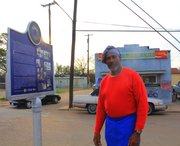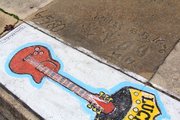Wednesday, February 27, 2013
Bluesmen such as Jimmy Holmes dot the trail, keeping the music of their fathers and grandfathers alive. Photo by Courtesy Julian Rankin
You can head south from Memphis through Oxford and over toward Winona before winding through the hills of Carroll County toward the grave of Mississippi John Hurt. Or from the Gulf Coast, turn north before cutting over toward the Delta. You can even begin your musical journey in Notodden, Norway, home of the annual Notodden Blues Festival, which continues to play host to dozens of Mississippi blues musicians; a marker pierces earth there.
Geographic routes of discovery on the Mississippi Blues Trail are as varied and plentiful as the paths weaving through the history of the music itself—music that began as spirituals, work songs and simple narrative ballads in African American communities in the South. My road started in Jackson, up Highway 49 to Bentonia, then on to Belzoni, and on into the Delta through Shaw, Indianola, Leland and Holly Ridge.
The Blues Trail began humbly—musicians stopped at the crossroads, treaded the soil, blazed the paths. Thanks to the work of the Mississippi Blues Commission, which has put together the meticulously researched stops along the trail (and an extremely useful smart phone application to accompany the trail), you can retrace the footsteps and pause at the hallowed spots. The metal blue markers are unmistakable, little beacons pointing the way to important lessons about the history of the Mississippi Blues. The first marker, installed back in 2005, is at the gravesite of Charley Patton, widely credited as the father of the Delta Blues.
Luther Brown, director of the Delta Center for Culture and Learning at Delta State University, is one of the original members of the Mississippi Blues Commission. With support from various federal and state agencies and private contributors, the Blues Trail has grown like a benevolent kudzu.
"Nobody involved believed we'd have as many markers in the ground as we do," Brown said. "We realized that there were a great many performers and locales and themes that all needed to be celebrated to really understand the blues."
'Notes on Top of Notes'
One of my first stops was the Blue Front Cafe in Bentonia. I tracked down the owner, Jimmy "Duck" Holmes, who had just finished chopping wood at his nearby home. He met me back down at the marker, and we sat on the front porch of the Blue Front Cafe, which his parents opened in 1948. As we talked, he scraped the dirt off his boots with the blade of a knife.
"I was introduced to my first guitar by one of the best: Henry Stuckey," Holmes said. "I didn't know then that he was as great a player as he was. He was one of the ones that pioneered the Bentonia style of music."
He continued cleaning the dirt from his boots. He stood up and walked over to a nearby mud puddle, dipping a rag into the water, then sat back down and rubbed his boots with the rag until they started to show a little shine.
"I knew those guys personally," he said of the old bluesmen. "My hat goes off to them. Most of those guys didn't read or write. And to think of a lyric or a song they had to have a photostatic memory to go back and rehearse it word for word. I used to set and watch those guys play, man. Notes on top of notes, bent notes on top of bent notes—they just had it in them."
Later, inside, Holmes played for me, demonstrating the Bentonia style of blues he carries on. The music echoed through the dim, empty juke joint. An SEC basketball game flickered on the television behind the bar; the announcers spoke softly, as if deferent to the song. Holmes had finished shining his boots, and they gleamed—even in the shadows.
As I packed my car to leave, three women pulled up. A young grandmother, her daughter and her daughter's daughter. Holmes sat in his chair on the porch, leg propped up against one of the beams.
Sheila Penning viewed the stop as an educational opportunity for her teenaged daughter. "My philosophy on education is if you can take a child and put them in that situation, they'll remember it a lot better than just reading it in a book. And if they can talk to people, and they can touch it and feel it and see it, it's just going to make that much more of an impact."
As I pulled away, I saw Penning take the spot on the stoop beside Holmes where I had been sitting, and they began to talk.
'Take Me Home'
Around Belzoni I began surfing through the radio stations. The first clear station streamed the blues. Between breaks in the song, a woman's voice spoke in deep, soothing tones. "The Delta and the blues get in you. And you can't get it out. Like roots of a tree, Delta John Hurt, Elmore James, B.B. King, Sonny Boy Williamson, wrapped their arms around me and welcomed me home. Home. That's right, take me home. Highway 61 Mississippi Delta Blues..."
I pulled into Indianola with the blues still coming through strong on the radio. I was driving down Church Street, itself a legendary stretch. I saw a woman on the sidewalk dancing. She moved, it seemed, to the same tune that was coming through my speakers. I had found the right wavelength.
I drove down further and parked. As I opened the door I heard that same radio station on full blast from storefronts and parked vehicles. All of us in the neighborhood were immersed in the same song.
A man cooking on a mobile barbecue pit greeted me. "Welcome to Indianola," he boomed.
His name was Ronnie Ward, owner of the mobile barbecue trailer and of the adjacent building, the Blues Corner Cafe. He was my new tour guide, the unofficial ambassador for this corner of the trail. We ducked inside his restaurant, and he rattled off an introduction to his cuisine: "Get your catfish, pulled pork, barbecue ribs, grilled tips, chicken wings, baked beans, potato salad, cole slaw, chitlins, green salad. We've got a host of great food."
"Get a good picture of those neckbones and rice," he said before we walked back out, pointing to the plate in front of one of the patrons.
The long exterior wall of the Blues Corner Cafe is covered in murals. Robert Johnson stares out with a cigarette hanging from his lips. "Robert Johnson is the one that got the two graves," Ward said. "They don't know where that cat is at." Scenes of field hands and fishermen and illustrations plaster the wall, painted, I'm told, by artist and musician Bobby Whalen.
Another marker stands firm on the corner a little ways down Church Street. A painting by Whalen of B.B. King's guitar, Lucille, colors the sidewalk. Two handprints and two footprints are embedded in the cement. They are King's, made in 1980—part of the geologic record of the blues. A street or two over, another blue sign stands in front of Club Ebony, which King bought in 2008 to save from closure.
Physical prints of booming businesses long gone also stake their claim here in the form of blank concrete slabs, cleared away. "This is the home of Eddie Phillip's pool hall where you're standing," Ward told me, pointing at my feet. "It's where all the guys shot pool, dice; it was just the spot when I was coming up as a boy.
"Right here was the dry cleaner and tailor shop," he said as we moved to another slab. "You could get a suit made and get your pants sewed up. And then the next spot right here was Dr. White. This was a black doctor right here in this town. If you got cut up on Saturday night, then bring your ass up here. He'd sew you up and send your ass back out."
We broke into laughter. "It's good to have it all in one place," I said.
Around dusk, I arrived at the grave of Charley Patton. The cemetery is tucked off a back road next to a cotton gin. The Blues Trail marker stands pristine by the roadside.
'Just Play'
One of the successes of the Mississippi Blues Trail is its accessibility. It's a tall order to make hundreds of widespread locales into a practical and worthwhile cultural attraction. The trail has its mythology and its mystery. But it also has people and places still alive with stories to tell. Every time you set off, you're in for a different adventure.
"The Mississippi Blues Commission, early on, made it very clear that we wanted to honor the people of the blues, the people who produced the blues," Luther Brown told me.
"It makes me feel good," Holmes added, "because it gives recognition to guys like Jack Owens, Skip James, Henry Stuckey. This place played a big part in the blues back in the early days. A lot of guys would just come out like at this time on Saturday afternoon with a guitar and harmonica and just play for whatever they could get. Set the hat down in front of them and just play until somebody come by and throw a nickel in there, a penny, whatever. And my mom said they'd play just as hard for that as they would for anything else."
The Blues Trail is authentic because it's not sanitized. Church Street and Club Ebony are in real neighborhoods where real people lead real lives. And the people I met took the time to welcome me with pride to their street corners; to share their piece of the Mississippi Blues.



